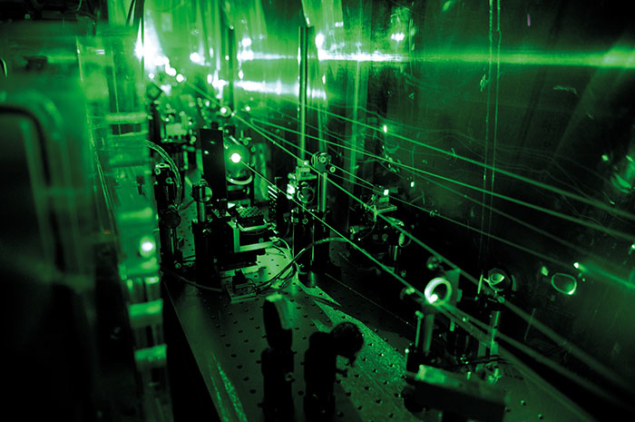
Image credit: PSI/A Antognini and F Reiser.
The international CREMA (Charge Radius Experiment with Muonic Atoms) collaboration has measured the radius of the deuteron more accurately than ever before, finding that it is significantly smaller than previously thought. The result, which was obtained using laser spectroscopy of muonic deuterium at the Paul Scherrer Institute (PSI) in Switzerland, is consistent with a 2010 measurement of the proton radius by the same group, which also showed a significantly smaller value than expected.
The 2010 result, which found a proton radius of 0.84087±0.00039 fm versus the CODATA value of 0.8751±0.0061 fm, formed the basis of what has been dubbed the proton-radius puzzle. The new measurement of the deuteron’s size gives rise to an analogous mystery. If the results hold firm, they could force physicists to adjust the Rydberg constant, which is currently known to the eleventh decimal place, and perhaps imply the existence of an as-yet-unknown force beyond the Standard Model.
Consisting of one proton and one neutron, the deuteron is the simplest compound nucleus. Its properties, such as the root-mean-square charge radius and polarisability, therefore serve as important benchmarks for understanding nuclear forces and structure. Using the most intense source of muons available, provided by the PSI proton accelerator, the CREMA team injected around 300 low-energy muons per second into an experimental chamber filled with gaseous deuterium molecules. Here, muons eject electrons from the molecules, which break up to form muonic deuterium. A complex pulsed laser system was then used to raise muonic-deuterium atoms from the metastable 2s state into the next excited state, 2p, after which the muons fall back to the ground state and emit an X-ray photon. Because the energy levels of the muonic atom strongly depend on the size of the nucleus, measuring the 2s–2p energy splitting in muonic deuterium by means of laser spectroscopy reveals the size of the deuteron with unprecedented precision.
Based on measurements of three 2s–2p transitions, the team found a value of 2.12562±0.00078 fm for the deuteron radius. This is 2.7 times more accurate but 7.5σ smaller than the CODATA-2010 value of 2.1424±0.0021 fm. The value is also 3.5σ smaller than the radius obtained by electronic deuterium spectroscopy. When combined with the electronic isotope shift, says the team, this yields a proton radius similar to the one measured from muonic hydrogen and thereby amplifies the proton-radius puzzle.
“You could say that the mystery has now doubly confirmed itself,” says lead-author Randolf Pohl of the University of Mainz, Germany. “After our first study came out in 2010, I was afraid some veteran physicist would get in touch with us and point out our great blunder. But the years have passed, and so far nothing of the kind has happened.”
As to the possible cause of the discrepancy, physicists remain cautious. “Naturally, it can’t be that the deuteron – any more than the proton – has two different sizes,” says CREMA-member Aldo Antognini of the PSI. The most likely explanation would be experimental imprecision, he says. For example, there could be an error with the hydrogen spectroscopy, which was used in some of the earlier measurements of both the proton and deuteron’s size. “If it should actually turn out that the hydrogen spectroscopy is giving a false – that is, minimally shifted – value, that would mean that the Rydberg constant must be minimally changed,” he says.
Currently, research groups in Munich, Paris, Toronto and Amsterdam are working to obtain more accurate measurements via hydrogen spectroscopy, and their results are expected in the coming years. The CREMA collaboration has also recently studied muonic helium-3 and helium-4 ions, and expects at least a five-fold reduction in uncertainties in their charge radii compared with the electron-scattering results. Next, the team plans to target the magnetic properties of the proton by measuring the so-called Zemach radius, which is the limiting quantity when comparing experiment and theory of the 1s hyperfine splitting in regular hydrogen.
“If all of the relevant experiments are correct, there must be some physics beyond the Standard Model going on,” says Gerald A Miller of the University of Washington, who was not involved in the PSI study. “In particular, the muon–proton and electron–proton interactions differ in ways that cannot be accounted for by the electron–muon mass difference, and that statement is strengthened by the newly published result.”
Further experiments should show whether the proton-radius measurements based on hydrogen atoms are less accurate than originally stated, he adds. One is CREMA’s measurement of the helium-4 radius using muonic atoms, while another is the MUon proton Scattering Experiment (MUSE) at PSI, which compares muon– to electron–proton scattering for both charges. “Given enough experiments, the proton-radius puzzle will be solved in a few years,” says Miller. “We can all speculate about the final result, but it’s more scientific to wait for results.”







